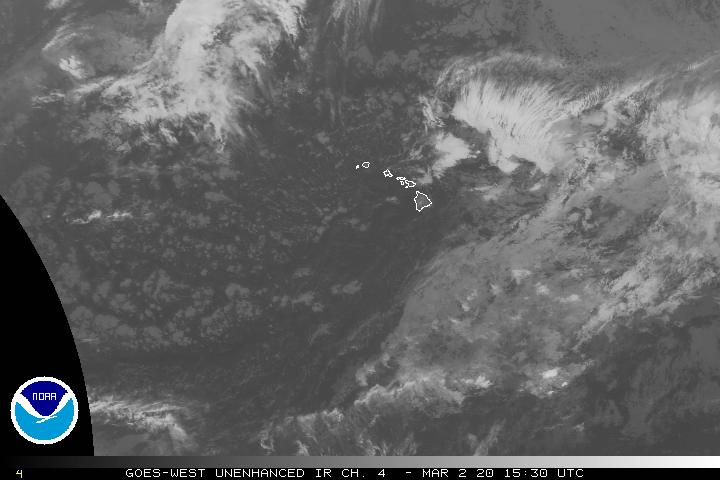Air Temperatures – The following high temperatures (F) were recorded across the state of Hawaii Monday…along with the low temperatures Monday:
87 – 75 Lihue, Kauai
87 – 73 Honolulu, Oahu
89 – 69 Molokai
91 – 68 Kahului AP, Maui
88 – 78 Kailua Kona
87 – 71 Hilo AP, Hawaii
Here are the latest 24-hour precipitation totals (inches) for each of the islands as of Monday evening:
0.65 Mount Waialeale, Kauai
0.84 Makaha Stream, Oahu
0.00 Molokai
0.00 Lanai
0.00 Kahoolawe
0.12 West Wailuaiki, Maui
0.06 Waikoloa, Big Island
The following numbers represent the strongest wind gusts (mph) as of Monday evening:
28 Port Allen, Kauai
30 Kuaokala, Oahu
28 Molokai
27 Lanai
37 Kahoolawe
27 Kapalua, Maui
44 Puu Mali, Big Island
Hawaii’s Mountains – Here’s a link to the live webcam on the summit of our tallest mountain Mauna Kea (nearly 13,800 feet high) on the Big Island of Hawaii. This webcam is available during the daylight hours here in the islands, and at night whenever there’s a big moon shining down. Also, at night you will be able to see the stars — and the sunrise and sunset too — depending upon weather conditions.
Aloha Paragraphs

Gale low pressure system far north…with a cold front

Thunderstorms southwest…a streak of high cirrus over the central islands
Clear to partly cloudy…cloudy areas locally

Showers locally – Looping radar image
Small Craft Advisory…windiest coasts and channels Maui County and the Big Island
~~~ Hawaii Weather Narrative ~~~
Broad Brush Overview: A trade wind weather pattern will continue, as high pressure remains far to the northeast of the state. Clouds and passing light showers will favor windward and mountain areas, with most leeward locations remaining dry. As we push into the weekend, an upper level low pressure system is forecast to pass westward, just north of the area…with a corresponding increase in shower activity expected.
Details: High pressure is centered far to the northeast of the state, with a ridge extending from the high, into the area north of the state. Aloft, a low is evident a few hundred miles west of Kauai. Satellite imagery shows rather stable low clouds, embedded in the trades east of Maui and the Big Island…with slightly deeper cumulus clouds around Kauai and Oahu. Radar imagery shows just a few light showers in the vicinity, affecting windward and mountain areas, and the adjacent coastal waters.
Looking Further Ahead: The islands will remain in a trade wind weather pattern, with winds speeds generally in the moderate range. Clouds and passing light showers will continue, with most leeward locations remaining dry. As we head into the weekend, an upper level low is forecast to move eastward toward the state. As a result, we’ll likely find a less stable airmass, prompting an increase in shower activity…along with lighter trades.
Here’s a wind profile of the Pacific Ocean – Closer view of the islands / Here’s the vog forecast animation / Here’s the latest weather map
Marine environment details: A Small Craft Advisory remains in place for the typically windier waters around the Big Island and Maui County. This is expected to remain posted at least through Thursday, and may need to be expanded to cover the windward Maui waters and the Kaiwi Channel by mid-week. Winds should ease up slightly by the weekend.
The locally strong trades combined with a northeast swell, will help keep choppy elevated surf along the windward shores for most of the week. However, surf is expected to remain just below the High Surf Advisory level. Some of the northeast swell energy will also likely wrap into exposed north facing shores across the state into mid-week. A small northwest swell is forecast for Friday and Saturday.
Small pulses from the southeast through the southwest will continue to produce near normal summer time surf (1-2 feet) along south facing shores. Reinforcing long south-southwest swells will generate moderate surf along south facing shores…starting Thursday into the weekend.

Stronger trade winds this week
>>> Southern California Weather Brief: An upper level trough off the California Coast will weaken high pressure aloft this afternoon, bringing a cooling trend as an onshore flow strengthens. One more day of very warm temperatures expected inland before cooling down to more normal highs for this time of year by mid-week. Expect low clouds and fog to redevelop Tuesday and continue through the week.

Just a few clouds…clear otherwise
World-wide tropical cyclone activity
![]()
>>> Atlantic Ocean: No active tropical cyclones
No tropical cyclones are expected during the next 5-days
>>> Caribbean: No active tropical cyclone
No tropical cyclones are expected during the next 5-days
>>> Gulf of Mexico: No active tropical cyclones
No tropical cyclones are expected during the next 5-days
Here’s a satellite image of the Caribbean Sea…and the Gulf of Mexico
Here’s the link to the National Hurricane Center (NHC)
>>> Eastern Pacific:
Hurricane 04E (Dora) remains active offshore from Mexico, here’s the NHC graphical track map, a NOAA looping satellite image…with what the computer models are showing…with a close up looping image of the eyewall feature / this storm won’t become a problem for the Hawaiian Islands
Here’s a wide satellite image that covers the entire area between Mexico, out through the central Pacific…to the International Dateline.
Here’s the link to the National Hurricane Center (NHC)
>>> Central Pacific: No active tropical cyclones
No tropical cyclones are expected during the next 5-days
Here’s a link to the Central Pacific Hurricane Center (CPHC)
>>> Northwest Pacific Ocean: No active tropical cyclones
>>> North and South Indian Oceans / Arabian Sea: No active tropical cyclones
Here’s a link to the Joint Typhoon Warning Center (JTWC)
Interesting: Rising seas could result in 2 billion refugees by 2100 – In the year 2100, 2 billion people – about one-fifth of the world’s population – could become climate change refugees due to rising ocean levels. Those who once lived on coastlines will face displacement and resettlement bottlenecks as they seek habitable places inland, according to Cornell University research.
“We’re going to have more people on less land and sooner that we think,” said lead author Charles Geisler, professor emeritus of development sociology at Cornell. “The future rise in global mean sea level probably won’t be gradual. Yet few policy makers are taking stock of the significant barriers to entry that coastal climate refugees, like other refugees, will encounter when they migrate to higher ground.”
Earth’s escalating population is expected to top 9 billion people by 2050 and climb to 11 billion people by 2100, according to a United Nations report. Feeding that population will require more arable land even as swelling oceans consume fertile coastal zones and river deltas, driving people to seek new places to dwell.
By 2060, about 1.4 billion people could be climate change refugees, according to the paper. Geisler extrapolated that number to 2 billion by 2100.
“The colliding forces of human fertility, submerging coastal zones, residential retreat, and impediments to inland resettlement is a huge problem. We offer preliminary estimates of the lands unlikely to support new waves of climate refugees due to the residues of war, exhausted natural resources, declining net primary productivity, desertification, urban sprawl, land concentration, ‘paving the planet’ with roads and greenhouse gas storage zones offsetting permafrost melt,” Geisler said.
The paper describes tangible solutions and proactive adaptations in places like Florida and China, which coordinate coastal and interior land-use policies in anticipation of weather-induced population shifts.
Florida has the second-longest coastline in the United States, and its state and local officials have planned for a coastal exodus, Geisler said, in the state’s Comprehensive Planning Act.
Beyond sea level rise, low-elevation coastal zones in many countries face intensifying storm surges that will push sea water further inland. Historically, humans have spent considerable effort reclaiming land from oceans, but now live with the opposite – the oceans reclaiming terrestrial spaces on the planet,” said Geisler. In their research, Geisler and Currens explore a worst-case scenario for the present century.
The authors note that the competition of reduced space that they foresee will induce land-use trade-offs and conflicts. In the United States and elsewhere, this could mean selling off public lands for human settlement.
“The pressure is on us to contain greenhouse gas emissions at present levels. It’s the best ‘future proofing’ against climate change, sea level rise and the catastrophic consequences likely to play out on coasts, as well as inland in the future,” said Geisler.












 Email Glenn James:
Email Glenn James:
Allan King Says:
This “interesting” article inspired me to write in my thoughts about the future of the human population. I cannot imagine where 3 to 4 billion more humans are going to be able to grow food and live. We already are using all the productive farmable land, a lot of which is river deltas and coastal areas that are some of the most productive lands that will be submerged as the sea level rises. What’s left is desert, rocky, high elevation areas. Or we can slash and burn the rain forest, eliminate most all other species to support us humans, which might give us a little more time. All this talk about what we’re going to do, where people are going to move to and how to “feed the world” neglects the root of the problem, there’s too many people. Humans have populated every square foot of this planet that can support a sustainable population. Humans are the most invasive species on the planet, plundering the resources world wide, sterilizing and poisoning the soil, polluting the air and water. I don’t want to be too negative here but what I’m saying is we have to practice birth control. We have to reduced the human population not increase it. The more people there are the worse the quality of life will be. What is the advantage of having 11 billion people? The idea that the resources of this planet are here for us to use is short sighted and will ultimately end the human population as we know it along with all life on earth. Bottom line is population control, not how can we get more out of what we have. Not many want to talk about that.
~~~ Hi Allan, thanks for chiming in on this important part of our current and future life here on this big round earth of ours.
I have to agree with you on your point of view, we can’t just keep taking everything there is to take, and then some. We can’t just keep adding to the current population endlessly.
It seems to be that the people of the planet just keep on acting as if business as usual…can last forever. There are too many signs already, that strongly suggest that big changes have to occur. One of the key issues, as you so aptly point out, is to get some control on our exploding populations. Eventually, and perhaps already, we will run out of room, and won’t be able to support all the hungry mouths.
Thank you for sharing your well written and inspiring comment…I totally concur.
Aloha, Glenn